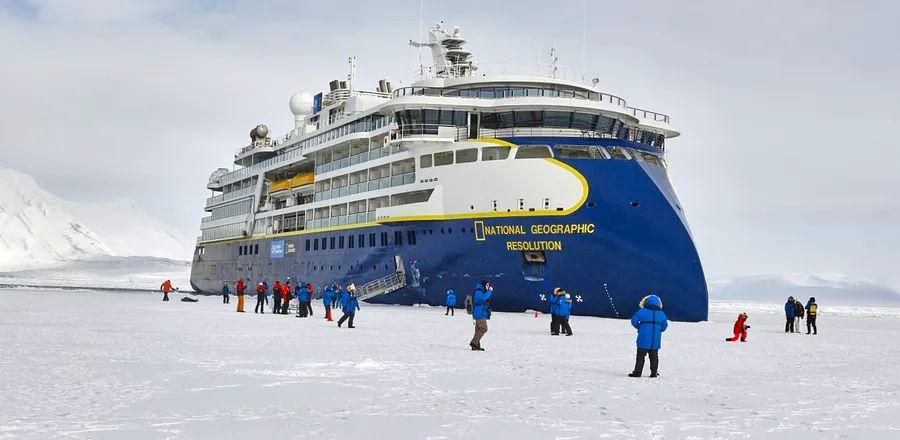9 Essential Tips for Your Arctic Cruise

The Arctic includes regions in Canada, Greenland, Norway, Sweden, Finland, Russia, and the U.S., featuring some of the most extreme and breathtaking wilderness areas on Earth.
Exploring the pristine beauty of the Arctic is often most accessible (and comfortable) via expedition ships. While cruise companies handle the itinerary details, there are several key considerations to keep in mind to prepare effectively for your journey.
Here’s what I discovered during a 10-day expedition to Svalbard with Lindblad Expeditions, along with insights from various expedition leaders about what to know before embarking on an Arctic cruise.
Select the operator that best suits your needs
The Arctic (all areas above 66.5622 degrees latitude) encompasses many locations; the most sought-after for cruises are:
- Svalbard (a group of islands situated halfway between northern Norway and the North Pole)
- Greenland
- Canada’s High Arctic and Northwest Passage (typically sailing from Reykjavík, Iceland, to Nome, Alaska)
- Franz Josef Land (an archipelago in Russia, though many voyages here have been canceled due to the conflict in Ukraine)
Although each operator has its own sailing approach, certain commonalities exist. Most Arctic cruises are conducted on smaller expedition vessels, accommodating between 100 to 300 guests (although larger lines like Holland America and MSC Cruises occasionally operate in the region). These expedition ships often do not dock at ports aside from embarkation and disembarkation, navigating wherever possible based on ice and weather, in search of wildlife and opportunities for off-ship excursions, such as hiking and Zodiac rides.
Arctic cruise durations vary, typically lasting from a week to around a month. Prices can start as low as $5,000 and can reach up to about $100,000.
Operators providing Arctic voyages include Hurtigruten, Lindblad, Oceania Cruises, Ponant, Quark Expeditions, Seabourn, Silversea, and Viking Cruises, among others.
Once you've settled on dates and budget, here are a few tips for choosing the right cruise line for your Arctic adventure:
- Identify your primary goals for the Arctic cruise. Are you eager to spot polar bears, add new bird species to your list, or engage with Canada’s Indigenous communities? Focus on what matters most to you and select an itinerary designed to fulfill that.
- Evaluate the size of the ship. The vessel you choose will impact your journey. Smaller ships can access more remote locations and minimize wait times for Zodiac excursions and landings. Conversely, larger vessels provide enhanced amenities, including gyms, spas, various dining options, and additional facilities. Clarifying your must-haves versus nice-to-haves will help refine your choices.
Approach the experience with an open mind and be ready to adapt.
“While expectations can be elevated, they are likely to be surpassed, but perhaps not in the manner you anticipate,” remarked Shaun Powell, director of field staff for Lindblad Expeditions. He emphasized that although it’s good to have high hopes, you shouldn’t let expectations or preconceived ideas about the journey shape your experience.
The key takeaway, he noted, is to remain adaptable. The ships venture into a vast wilderness where weather, ice, and wildlife dictate the itinerary. Nothing is fixed (daily plans will frequently adjust), and circumstances may not unfold as intended. Yet, it’s often these unplanned moments that create the most unforgettable experiences and memories, such as having the chance to linger longer at a site to observe a polar bear hunting a seal or witnessing the dynamic nature of ice as it shifts, melts, and transforms, highlighting its implications for our planet and climate.
“These are remarkable, unconventional, and breathtaking locations. Their wild nature cannot be entirely captured or defined by a brochure, a TikTok clip, or an Instagram post,” Powell remarked. “The environment is constantly evolving, and its wildlife is always on the move. However, if you embark on your adventure with an open heart, you'll discover that each day offers experiences that surpass your expectations. Just be ready to embrace these ever-changing landscapes.”

Bailey Berg
Prepare for unpredictable weather conditions.
Temperatures in the Arctic can fluctuate (and plummet) swiftly due to wind chill or unexpected cloud cover.
Most Arctic cruises operate between May and September, when temperatures generally range from the 10s to 20s degrees Fahrenheit. However, some cruises may run slightly earlier or later, in which case, you should prepare for single-digit temperatures.
According to Powell, the key to staying comfortable is wearing outer layers, such as waterproof coats and pants that provide wind protection. The windbreaker feature is essential because even on sunny days, the wind can be quite chilling. Waterproofing is crucial to guard against rain and the splashes caused by the winds when traveling in a Zodiac—nothing makes you feel colder than being wet.
Beneath the outer layer, layering is vital. Expedition teams typically suggest wearing a merino wool base layer, a warm mid-layer like fleece, and possibly a puffy jacket if you're prone to feeling cold (similar to what you might wear skiing). Powell also advises ensuring the layers aren’t too tight.
“People often choose layers that end up being too snug, not realizing that the air trapped between layers is what provides essential warmth and comfort in these icy environments,” Powell explained. “A slightly looser fit is preferable. One pair of high-quality, thick socks is better than cramming into several pairs that cut off circulation to your toes. Mittens are more effective than gloves, and a puffy vest under your outer layer is typically superior to multiple fleece layers.”
A backpack (ideally waterproof to protect your camera equipment) is crucial for carrying extra layers, gloves, and hats, or for stowing away a removed layer. Additionally, sunscreen and sunglasses are essential, as the sun's rays reflect off the ice.
Invest in quality, tall boots
The Arctic destinations you will explore often require “wet landings.” For these excursions, a Zodiac will ferry you from the ship to the shore, and you’ll need to step into shallow water. A reliable pair of waterproof, high-top (at least mid-calf) insulated boots is essential.
Check with your cruise provider to see if they offer rental or borrowing options, which can help reduce the weight of your luggage. Some cruise lines, like Lindblad, collaborate with external operators such as Ship to Shore to provide boots for their guests. Others, like Hurtigruten, supply complimentary boots for Arctic voyages.
I opted for my neoprene Xtratuf boots, which performed well, but I noticed that Hunter, Bogs, and Muck Boots were popular among my fellow travelers. A helpful tip: bring a pair of insoles to boost comfort, as you’ll be walking quite a bit in those boots.
Don’t forget to prepare for the departure city
Your journey typically begins with a few days in a major city, such as Oslo for a Svalbard cruise or Reykjavík, Iceland, for a Northwest Passage trip, allowing guests to meet the expedition team and ensuring any lost luggage can be reunited with its owner. (It's wise to pack essential items, like medications and vital cold-weather gear, in your carry-on—one woman on my trip never received her suitcase and had to borrow clothes for the entire voyage.) During this time, opt for lighter layers—you wouldn’t want to be that person visiting the Munch Museum and Nobel Peace Center fully dressed in Gore-Tex (especially in July). Depending on your operator, there may be organized excursions or opportunities for self-exploration. Be sure to review your itinerary in advance and plan accordingly.
Prepare to stay up late to witness stunning sunsets (and possibly the northern lights)
“Regardless of when you travel to the Arctic, you will have the chance to experience the breathtaking colors and light,” shared Tessa van Drie, an expedition leader for the Norwegian line Hurtigruten. She noted that during summer, the sun doesn't set but rather lingers low on the horizon. “The best light I’ve encountered was when the sun was just above the horizon while sailing in Disko Bay, Greenland—the icebergs appeared golden.”
As the days shorten—typically from October to March—you may catch a glimpse of the northern lights. It’s advisable to download an aurora forecast app, such as My Aurora Forecast and Alerts, in advance to stay informed about the best times for spotting the lights in your vicinity.
Morning wake-up calls are often scheduled for breakfast, although most modern ships are equipped with intercoms for each cabin. If you’ve stayed up late and prefer to sleep in, you can mute the speaker. However, considering you’ll be in the Land of the Midnight Sun, it might be a good idea to bring a sleep mask as well, in case your cabin lacks blackout curtains.

Bailey Berg
Don't forget to pack a camera, perhaps some extra lenses, and quality binoculars
Whether you're shooting with a smartphone or a professional DSLR, you'll surely capture stunning images of the Arctic. Brent Stephenson, a photographer and expedition leader for Lindblad, suggested having a range of lenses if you can.
“Long lenses are excellent for photographing wildlife, but you'll also want mid-range zooms and wide-angle lenses to truly capture the landscapes and the essence of the area,” explained Stephenson. “A collection of tightly cropped wildlife photos might bore your friends during your post-trip slideshow. Instead, including a variety of images that showcase your travels, the scenery, the light, the glaciers, the mountains, your fellow travelers, and the ship will create a much richer narrative of your journey for friends and family.”
Regarding binoculars, your ship will probably provide some for you to borrow, but if you own a pair that you prefer and know how to operate, it's definitely a good idea to bring them. The ability to zoom in on wildlife—whether it’s a bird, seal, walrus, whale, or polar bear—or on the stunning landscapes will significantly enhance your viewing experience.
Gain a deeper insight into the history of Arctic expeditions
You’ll have plenty of downtime on the ship while the crew searches for wildlife or prepares for off-boat activities, so consider bringing along a few books. Expedition leaders recommend several titles that can provide a richer understanding of the regions and communities you’ll be exploring:
- The First Crossing of Greenland by Fridtjof Nansen
- In the Kingdom of Ice: The Grand and Terrible Polar Voyage of the USS Jeannette by Hampton Sides
- Hearts in the Ice: The Adventures of the First Two Women to Overwinter Solo in Svalbard by Sunniva Sorby and Hilde Fålun Strøm
Be ready to face the realities of a shifting climate
Visiting one of the most isolated regions on the planet offers a firsthand glimpse of the impacts of climate change. The effects of our warming world are particularly evident in the delicate High Arctic.
These journeys have only become feasible in recent decades, largely due to advancements in technology, such as more powerful engines and specially designed bows that navigate through ice more effectively. Additionally, the lengthening summers and retreating sea ice, attributed to climate change, have made these expeditions possible.
Tourism is indeed a contributor to climate change, with Sustainable Travel International estimating that around 8 percent of global greenhouse gas emissions stem from this sector each year.
Fortunately, many companies operating in the Arctic are implementing greener practices, from banning single-use plastics on board to adjusting their cruising speeds to reduce fuel consumption. Some are even redesigning their vessels for greater sustainability, such as Hurtigruten’s Roald Amundsen, the first electric hybrid ship classified for polar use.
However, your presence will still have an effect. Experiencing the tangible consequences of climate change on both the environment and wildlife can inspire a new movement dedicated to protecting the Arctic, as noted by Sven Lindblad, CEO of Lindblad Expeditions, during my Svalbard voyage.
“It’s vital for people to experience these places, understand their significance, and cultivate a sense of respect and appreciation for their existence,” said Lindblad.
Evaluation :
5/5



